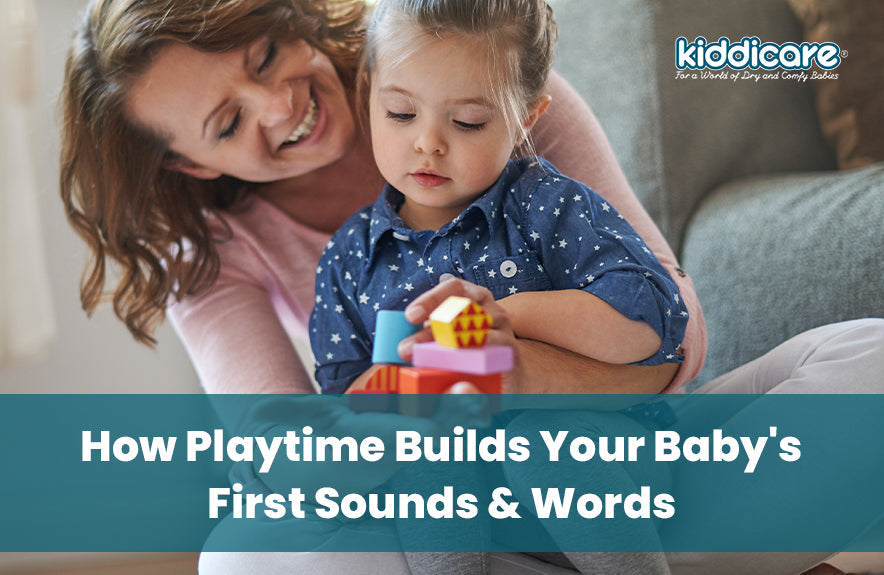
How Playtime Builds Your Baby's First Sounds & Words
Playtime is more than just fun and giggles for your baby, it's a crucial stage in their language development journey. From the very first coos and gurgles to the first recognisable words, playtime lays the foundation for communication, social interaction, and cognitive development. In this article, we'll explore how everyday play helps babies develop their first sounds, words, and ultimately, their ability to communicate effectively.
Tips for Building Your Baby's First Sounds & Words
Understanding Early Language Development
From birth, babies are wired to communicate. Though they cannot yet form words, their early interactions with sounds, facial expressions, and gestures are the building blocks of language. Research shows that babies start processing speech sounds from as early as 4 months in the womb, recognising the rhythm and melody of their parents' voices.
By the time they reach 6–12 months, most babies begin to babble, experimenting with sounds like "ba-ba" or "da-da." This stage is critical, as it lays the foundation for later vocabulary growth.
Why Playtime is Essential for Speech
Playtime is not just about entertainment, it is a form of learning. When babies engage in play:
- They practice listening skills. Hearing different tones, words, and rhythms strengthens their auditory processing.
- They experiment with sounds. Every coo, giggle, and babble is a trial-and-error attempt at forming speech.
- They build social bonds. Interaction with caregivers during play helps babies understand turn-taking, a key component of conversation.
By making play interactive and language-rich, parents provide a natural environment for speech development.
The Role of Sounds and Cooing
Cooing usually begins around 6 to 8 weeks. These vowel-like sounds may seem simple, but they are a baby's first experiments with communication.
During playtime, caregivers can encourage cooing by:
- Mimicking the baby's sounds.
- Smiling and making eye contact.
- Introducing gentle vocal play, such as humming or singing.
Coos strengthen oral muscles and teach babies that their sounds can elicit responses, a foundational principle of conversation.
Babbling: Your Baby's First Language Experiments
By 4–6 months, babies progress from cooing to babbling, where consonants and vowels are combined. Examples include "ba," "da," or "ma."
Babbling is crucial because it:
- Practice speech patterns. Babies experiment with intonation and rhythm.
- Encourages imitation. They listen to their parents and try to copy sounds, which helps them form their first words.
- Prepares the mouth and tongue. Babbling strengthens the muscles needed for articulation.
Playtime activities such as peek-a-boo, rolling balls, or puppet shows provide perfect opportunities for babbling practice.
Interactive Play and Word Learning
Once babies begin babbling, interactive play becomes crucial in helping them turn sounds into words. Naming objects, repeating sounds, and describing actions during play help babies connect words with meaning.
Examples:
- Point to a ball and say, "Ball!"
- Stack blocks and say, "Up!"
- During bath time, name water toys: "Duck, boat, cup."
This repetitive, engaging exposure accelerates vocabulary development.
Reading Aloud: Playtime Meets Storytime
Reading aloud is a form of play that significantly benefits language development. Babies absorb sounds, rhythms, and patterns from the books they read. Board books with bright pictures, simple words, and repetitive phrases are ideal for early play-reading sessions.
Tips for maximising playtime reading:
- Use different voices for characters.
- Encourage the baby to point at pictures.
- Pause to let the baby respond with sounds or gestures.
This form of play encourages auditory discrimination and early comprehension skills.
Music and Rhymes: The Sound of Learning
Songs, nursery rhymes, and musical play stimulate a baby's auditory senses. Rhythm and rhyme are essential for phonological awareness, which enables the recognition of sound patterns in words.
Fun ideas:
- Clap hands to the beat of a song.
- Sing simple, repetitive songs like "Twinkle, Twinkle."
- Use instruments like shakers or tambourines.
Musical play also enhances memory, attention span, and the ability to predict patterns, all of which are critical for language development.
Gestures, Expressions, and Nonverbal Language
Language is not just words. Babies communicate through gestures, facial expressions, and body movements. Playtime encourages these early forms of communication:
- Waving "bye-bye."
- Pointing at toys or objects.
- Showing excitement or frustration during games.
These nonverbal cues teach babies the basics of conversation, turn-taking, and social communication.
Playful Questioning: Encouraging Early Speech
Even before babies can answer questions, asking them questions during play encourages vocal experimentation.
- "Where's the ball?"
- "Can you clap your hands?"
- "What sound does the dog make?"
Such questioning exposes babies to new vocabulary and teaches them that communication is a two-way exchange.
Social Play: Mimicking and Turn-Taking
Social play with parents, siblings, or peers teaches babies how to mimic speech, follow conversation cues, and take turns.
Games like:
- Peek-a-boo
- Patty-cake
- Simple role-playing
…introduce the concepts of cause and effect, attention sharing, and interactive dialogue. These are vital skills for later communication.
Choosing the Right Toys for Language Development
Certain toys can accelerate language learning during play:
- Soft toys with textures and sounds for tactile and auditory exploration.
- Interactive books with flaps and buttons.
- Musical instruments like xylophones or shakers.
- Building blocks that encourage naming colours, shapes, and actions.
The key is to select toys that invite interaction, imitation, and exploration.
Tips for Encouraging Early Sounds at Home
- Narrate daily activities: Describe what you're doing: "Mommy is washing the dishes."
- Respond to every sound: Show your baby that their coos or babbles are meaningful.
- Use gestures alongside words: Point, clap, or wave while naming objects.
- Create a playful environment: Safe spaces, colourful toys, and singing sessions encourage exploration and learning.
- Limit screen time: Human interaction is far more effective for speech than passive screen exposure.
When to Worry About Speech Delays
While every baby develops at their own pace, sure signs may indicate delays in speech and language development:
- Lack of cooing or babbling by 12 months.
- No gestures, such as pointing or waving, by 12 months.
- Minimal response to sounds or voices.
- Limited vocabulary by 18–24 months.
If you notice these signs, consulting a paediatrician or a speech-language pathologist is recommended. Early intervention can make a significant difference.
Summary
Playtime is not just fun; it's the gateway to language development for your baby. Babies learn to recognise sounds, form words, and communicate their needs through cooing, babbling, reading, singing, and interactive games. Engaging in playful interactions, using gestures, responding to sounds, and providing language-rich experiences helps transform play into a powerful tool for speech development. By prioritising playtime, parents can nurture their baby's first words and a lifelong love for learning and communication.
Ready to Support Your Baby's Language Journey?
Every coo and giggle brings your little one closer to their first words. Keep your baby comfortable and happy during every play and learning moment with Kiddicare Nappies and Baby Wipes. Our ultra-soft, leak-proof nappies and gentle, skin-safe wipes make everyday care stress-free and straightforward.
👉 Shop Kiddicare Nappies & Wipes today for comfort, care, and confidence for every playful moment!



